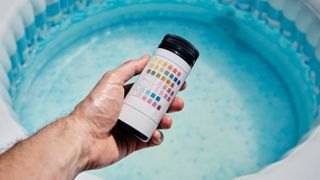Having the right chemicals to balance your hot tub water is essential, from balancing out pH and alkalinity, to ensuring the water is sanitized to a level that’s safe, without causing irritation. Our hot tub supplies list talks you through what you’ll need to stop cloudy, green or foamy water, bacteria, scale, and more. Plus, we lift the lid on what could happen if you don’t. Plus, if you’re still undecided about whether to invest in a hot tub, you’ll find a range of options in our best hot tubs (opens in new tab) buying guide, from affordable inflatables to full-on luxury spas with the wow factor.
Hot tub supplies: What do you need?
If you’ve just bought a hot tub, you’ll need some essential supplies to keep it safe for you, your family, or your guests. Below, we’ve listed what you’re likely to need:
- Testing strips Essential for checking the pH of your hot tub’s water, alkalinity, and chlorine levels, testing strips are inexpensive and easy to use. Simply dip a strip in your hot tub’s water for a second or two, and compare the color that develops on the strip to the color chart provided, which is usually printed on the side of the packaging. • pH: Levels should ideally be between 7.2 and 7.8 • Chlorine: Levels should be between 3 and 5 mg • Alkalinity: Should be between 80 and 120 mg ppm (parts per million) Not testing your hot tub water will result in an imbalance of chemicals in the water, which can cause, among other things, algae and bacteria build-up and corrosion to your hot tub. Not to mention problems with skin irritation, burning eyes, and more serious health problems caused by harmful microbes (opens in new tab). You’ll need to test your hot tub water every couple of days.
- pH adjusters pH increasers and decreasers allow you to adjust the pH of your water so that it is at a safe level for bathers. Once you’ve tested your water, simply add the recommended amount of granules to your hot tub water to increase or decrease the pH, and check again after a few hours. Not adjusting your pH levels can have consequences, according to Laurence Hookway, Sales Manager at Aqua Spa and Leisure (opens in new tab). “When your pH is in between 7.2 and 7.4, your sanitizer is at its most effective. As your pH rises, the efficacy of your sanitizer drops.” A low pH means there is more acidity in the water, which can corrode the working parts of your hot tub and the walls of the pool itself. It can also cause irritation to the eyes and nose.
- Sanitizer Essential for any safe hot tub, you’ll need a sanitizer to keep bacteria and other microbes at bay. There are two sanitizers available: chlorine or bromine. Hookway recommends opting for bromine over chlorine when it comes to choosing a sanitizer, as bromine is considered to be more stable than chlorine, and has a lower pH. This means it can be more effective over a longer period. While chlorine can kill contaminants quicker than bromine, it will need to be replaced more often, usually once a week. Whichever sanitizer you use, follow the instructions carefully and ensure you replace it as and when needed. Continue to test your water every couple of days to ensure your water is clean and safe. Without sanitizer, your hot tub water will quickly become a host to bacteria, posing a health risk to anyone that uses it.
- Shock treatment Even with sanitizers, bacteria in your hot tub can multiply without a shock treatment to rebalance the water and remove impurities. Experts recommend shocking the water once a week to reactivate the existing sanitizers. This means adding a treatment to oxidize the water with a higher than usual dose of chemicals. You can opt for chlorine or non-chlorine shock treatments, or use both. If you opt for chlorine shock, you’ll need to wait for the chlorine in your water to return to a safe level before you use your hot tub. If you decide to use non-chlorine shock, you can use your hot tub around 20 minutes after the shock treatment. Always read the shock treatment packaging carefully and use the recommended dosage for your hot tub’s volume of water.
- Sequestering agent Water can contain metals and minerals that can give your hot tub water a red, brown, green, or orange hue. Adding a sequestering agent at the time of filling your hot tub up can help to remove these, to give you clear and sparkling water.
- Defoamer Experts recommend having a shower before getting in your hot tub, to avoid any lotions, moisturizers, cosmetics, and other products making the water foamy, However, it’s easy to forget, especially if you’re having a party. A defoamer can reduce the foam temporarily to avoid unnecessary bubbles.
- Calcium-adjusting chemicals A build-up of calcium in your hot tub can lead to cloudy water, and scale can quickly build up on the walls of your tub. Adding a calcium increaser or decreaser can help to reset calcium levels and give you clear water and no nasty scaling. As with all your hot tub chemicals, make sure you test the water with a test strip before and after adding chemicals, and read the instructions carefully before using.
- Storage for chemicals Chemicals used for hot tubs can be extremely dangerous if swallowed, so you need to keep them out of reach of children and pets. They are also sensitive to heat and moisture, so should be stored somewhere dry and cool. Use a lockable container that can be stored in a cool place, such as the garage, off the ground. Discover more guides for the garden… Best patio heaters Best chainsaws Best swim spas
You can read more of Joanne’s work and get in touch via her website: https://www.joannelewsley.co.uk/






